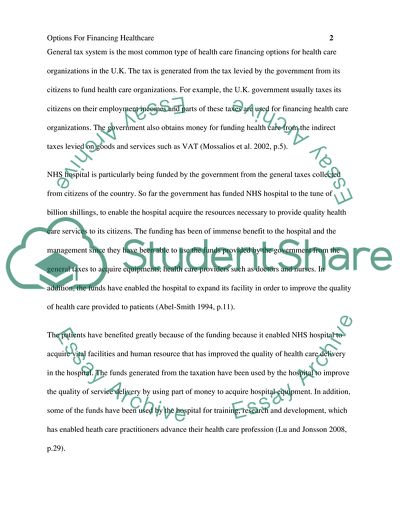Cite this document
(Options for Financing Healthcare Coursework Example | Topics and Well Written Essays - 2000 words - 1, n.d.)
Options for Financing Healthcare Coursework Example | Topics and Well Written Essays - 2000 words - 1. https://studentshare.org/health-sciences-medicine/1788757-a-written-assignment-critically-discussing-the-options-for-financing-healthcare-for-a-chosen-service-user-group-or-for-a-chosen-health-care-setting-service-2000-words
Options for Financing Healthcare Coursework Example | Topics and Well Written Essays - 2000 words - 1. https://studentshare.org/health-sciences-medicine/1788757-a-written-assignment-critically-discussing-the-options-for-financing-healthcare-for-a-chosen-service-user-group-or-for-a-chosen-health-care-setting-service-2000-words
(Options for Financing Healthcare Coursework Example | Topics and Well Written Essays - 2000 Words - 1)
Options for Financing Healthcare Coursework Example | Topics and Well Written Essays - 2000 Words - 1. https://studentshare.org/health-sciences-medicine/1788757-a-written-assignment-critically-discussing-the-options-for-financing-healthcare-for-a-chosen-service-user-group-or-for-a-chosen-health-care-setting-service-2000-words.
Options for Financing Healthcare Coursework Example | Topics and Well Written Essays - 2000 Words - 1. https://studentshare.org/health-sciences-medicine/1788757-a-written-assignment-critically-discussing-the-options-for-financing-healthcare-for-a-chosen-service-user-group-or-for-a-chosen-health-care-setting-service-2000-words.
“Options for Financing Healthcare Coursework Example | Topics and Well Written Essays - 2000 Words - 1”. https://studentshare.org/health-sciences-medicine/1788757-a-written-assignment-critically-discussing-the-options-for-financing-healthcare-for-a-chosen-service-user-group-or-for-a-chosen-health-care-setting-service-2000-words.


